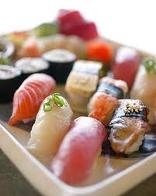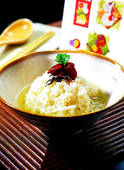Japanese Cuisine ….. ‘oishi desu ne’

The eating ‘habits’ of modern day Japan developed over many hundreds of years. A major influence during this period was the introduction of rice from Korea about 300 years CE (Soy beans and wheat were Introduced from China not long after this). Rice growing methods were learned by migrating groups of people entering Japan in the Yayoi period. Rice was also used for making paper, wine and fuel.
Zen Buddhism arrived in Japan as early as 700CE but had no significant influence until somewhere around 1200 CE. From this point many temples appeared across the land and food served at the services in these temples was vegetarian (Shojin ryori).This diet was based on the Buddhist bans on the killing of living things and this quickly became the common daily meal type for many people.

Now, when we look at the diet of modern Japan we find traditional Japanese cooking living happily with cooking styles from around the world, often adapted to Japanese tastes. This is very similar to changes that the Australian ‘typical’ diet has been experiencing since European, Asian and Middle Eastern people making their homes in Australia have influenced our eating habits with a wonderful variety of foods, cooking styles and techniques.

Finally, we can see 3 strong features in Japanese traditional cooking:
1) Freshness and flavour of the ingredients
2) A sense of decorative skill in the placement of food on the plates and other receptacles
carefully chosen to suit the food being served. Seasons, Nature and colour are
always considered in this process.
3) As Japanese cooking comes from a vegetarian culture the staple food is still rice (bread
in Australia?). Fish and vegetables make up the majority of the other foods served. 
Bon appetit
